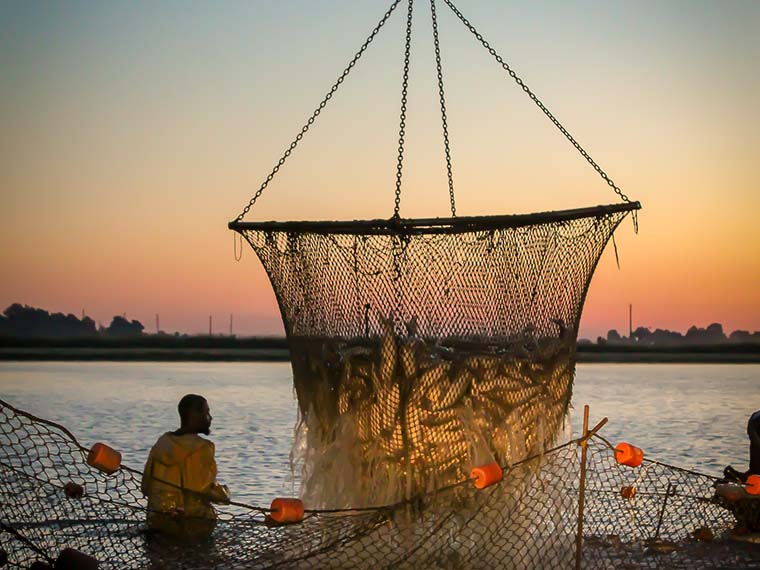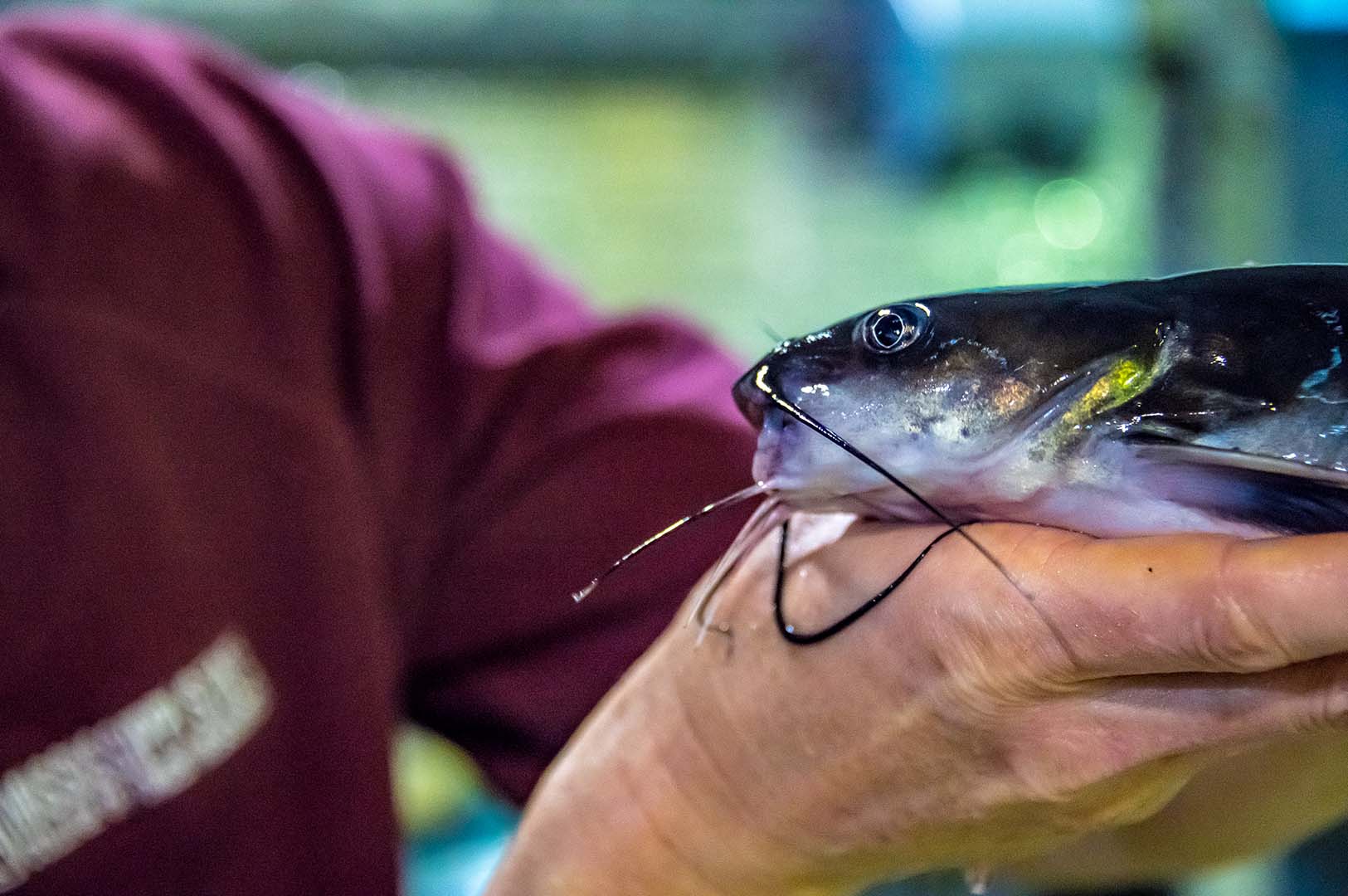The information presented on this page may be dated. It may refer to situations which have changed or people who are no longer affiliated with the university. It is archived as part of Mississippi State University's history.
Mississippi raises the most catfish in the U.S., with 34,700 pond acres across 155 operations totaling an annual production value of $181 million dollars. Stress can take a toll on farm-raised catfish and may also affect the end product. That's why MAFES scientists have spent five years studying the impact stress has on catfish from farm to table and fingerling to fillet.
Over the course of several studies, Drs. Peter Allen and Wes Schilling evaluated how environmental and handling stressors impacted the fish as well as the fillet quality and consumer perception.
"I have always wanted to help the catfish industry, whether it's helping them do what they do better or evaluating bottlenecks or challenges they may have," said Allen, who is also an associate professor in the Department of Wildlife, Fisheries and Aquaculture in the College of Forest Resources and a researcher in the Forest and Wildlife Research Center.
Allen said the team worked with farmers and processors to evaluate actual environmental and handling conditions experienced by catfish.
"Fish are closely connected to their environment and may not be adapted to an aquaculture environment with its shallow, exposed ponds and high densities of fish," Allen said. "While fish are often resilient to environmental changes, extreme conditions or a combination of different conditions can cause stress."
The researchers evaluated short-term and long-term stressors.
"Short-term and long-term stress refers to the time period reflecting environmental conditions that fish would be subjected to in ponds," Allen explained. "Fish were subjected for short time periods, about 12 hours, whereby a relatively rapid change occurred, or for longer time periods, up to 4 weeks, so we could evaluate the effects of prolonged problematic conditions."
Environmental stressors included aspects of water quality, such as temperature and dissolved oxygen.
"We studied low to high oxygen levels and moderate to high temperatures, with low oxygen and high temperature generally thought to be the most intense environmental stressor," Allen said.
In terms of water quality, dissolved wastes such as carbon dioxide, ammonia and nitrite were also evaluated. Water buffer capacity which included alkalinity, hardness, and pH was analyzed as well.
The team also studied sequential stressors, occurring one after the other, which included environmental stressors that simulated culture in ponds along with stressors in the sock (a netted enclosure) and during hauling when stressful pond conditions were followed by crowding and confinement.
Allen explained that fish respond to stressors through physiological changes cumulatively known as the stress response.
"Stress is defined most simply as a departure from homeostasis. Typically, we think of stress as a fight or flight response and it's not that different for fish. Whenever conditions change for fish, they also mobilize energy to respond to a stressor in a fight or flight response," Allen explained. "Stressful environments may reduce feeding, growth, and affect muscle which consumers may experience in fillet quality."
Physiological stress was evaluated after each stressor. The team took blood and tissue samples and compared different types of physiological metrics of stress. They measured changes through analysis of energy substrates and circulating metabolites.
"We studied stress hormones and metabolites for a short-term evaluation of stress," Allen said. "We also analyzed the impacts of certain environmental conditions on growth performance and survival to formulate a big picture of what these conditions mean over the long-term at the fish level and for the farmer as well."
Allen said he's been impressed with the resilience of catfish throughout the research.
"They are an excellent agricultural species. We knew catfish were pretty tough, but they do have limits to stressors, and we were able to establish what some of those limits were," Allen said.
The research helped establish best practices for producers, including minimizing harvest at elevated temperatures, reducing fish densities in hot summer conditions, and minimizing time in the sock and time from transport to processing. He also pointed to the USDA ARS research recommendation of keeping oxygen levels above three milligrams per liter.
"Doing that will ensure fast growth but will also help fish be more resilient to stressors," he said.
Once the fish were processed, food scientists evaluated changes in the sensory and quality characteristics of the fillets. That part of the research was led by Schilling, who is also a professor in the Department of Food Science, Nutrition and Health Promotion in the College of Agriculture and Life Sciences. The stressed fish didn't eat as much or grow as fast, which resulted in smaller fillets. However, the researchers were able to determine that stress did not seem to impact the end product.
"Our most significant finding was that stress didn't negatively affect the fillet quality or acceptability. We weren't expecting that," said Schilling, who also pointed out that fish that were stressed in the pond demonstrated greater resilience when exposed to stressors during handling. "We concluded that this must be due to the fact that they were already predisposed to stress."
In another study, the team sought to determine if stress caused red fillet, a color defect that results in rejection of catfish fillets by processors, and causes annual losses of approximately $175,000 per processing plant.
The team used proteomics, which evaluates proteins expressed in the catfish fillets that were harvested from fish that were exposed to different environmental conditions. They analyzed several proteins and determined that the only protein-hemoglobin-was found in greater abundance in stressed fish.
"Hemoglobin had a 22-fold greater abundance in red-catfish fillets. This led to the conclusion that the red color defect in catfish fillets is primarily due to the over-abundance of hemoglobin, which could be caused by rupturing of blood vessels due to stress and/or contamination with a hemolytic pathogen," Schilling said.
While the team was unable to produce a red fillet in the laboratory setting, they are conducting additional research in collaboration with Dr. Lora Petrie-Hanson, associate professor in the basic science department in the College of Veterinary Medicine, to further study how stress and disease impact the onset of red fillets.
Much of the research was led by Michael Ciaramella, who served as lead author on two of four published articles. Ciaramella earned a doctorate in food science and technology in 2016 and was a recipient of a MAFES doctoral fellowship.
"This project was very complex on both the aquaculture and food science side. I don't know anyone else that could have done the research as well as Michael did," Schilling said. "He just did an amazing job being able to figure out all of the moving parts of the research."
Shay Allred also worked on the research earning a master's in wildlife, fisheries and aquaculture in 2018. Michael B. Arnold, a wildlife, fisheries and aquaculture master's student, previously worked on the research, graduating in 2012.
In addition to MAFES, funding was provided by the USDA Agricultural Research Service. Findings from the team's research have been published in the Journal of Food Science, Meat Science, the North American Journal of Aquaculture, and Comparative Biochemistry and Physiology, Part D.


